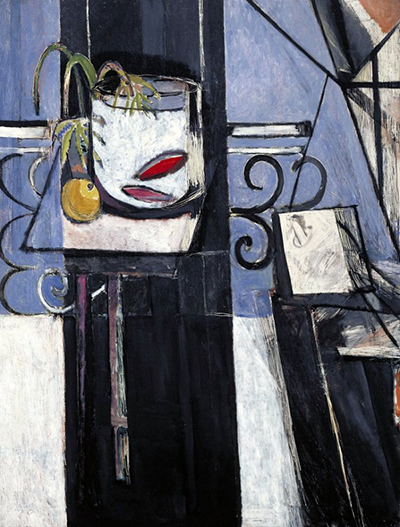This painting was constructed in 1914 and would have offered a timely distraction from the start of WWI which had already swept across much of Europe. Matisse always managed to lure us into his fantastic world of colour and abstraction.
Matisse, by this point in his career, have developed a truly contemporary approach which flattened perspective and re-arranged objects into a new structure. He would use goldfish within several of these depictions (most famously in 1912), though in this example it plays a less prominent role than as seen in the others. The colour scheme is also subdued, with a large use of black and white with blue for the background. That ensures that the red fish and the yellow apple to the side both catch your attention, even though they are not directly in the centre of the composition. Therefore, they are important even though the artist chooses not to thrust them directly at you. Behind the tank is a small plant which is starting to grow over the edge of it. They sit on a glass table, with an iron fence just behind.
The look reminds us of perhaps a small flat with a balcony. Perhaps the large black stripe down the middle is part of a door leading outside. Matisse's method of flattening perspective and varying angles makes it much harder to decipher every element of his scenes, though his career also featured many other styles at different points of his development. The subdued colour schemes would ensure that this interesting painting would never be amongst his most popular, but for those knowledgeable on Matisse's oeuvre, there are some important additions here which help us to track his development from a traditional artist, originally, to a more modern painter who embraced fauvism, cubism and so much more.
Still life art was a traditional genre which could be seen in France several centuries earlier, such as with the brilliant work of Chardin, who gave us the likes of The Ray. This was his most famous painting and is actually known to have shocked several different artists, include Henri Matisse, who were amazed when viewing the piece in person - they were amazed by the photo-realistic qualities of his depictions which they could not believe were even possible. This may have influenced Matisse to attack still life art, but he would take a very different approach, stylistically. We would also see the same with Georges Braque, who took still life content into his cubist approach, something that he developed in tandem with a certain Pablo Picasso. Braque's more memorable contributions included Fruit Dish and Glass and Plate and Fruit Dish.




